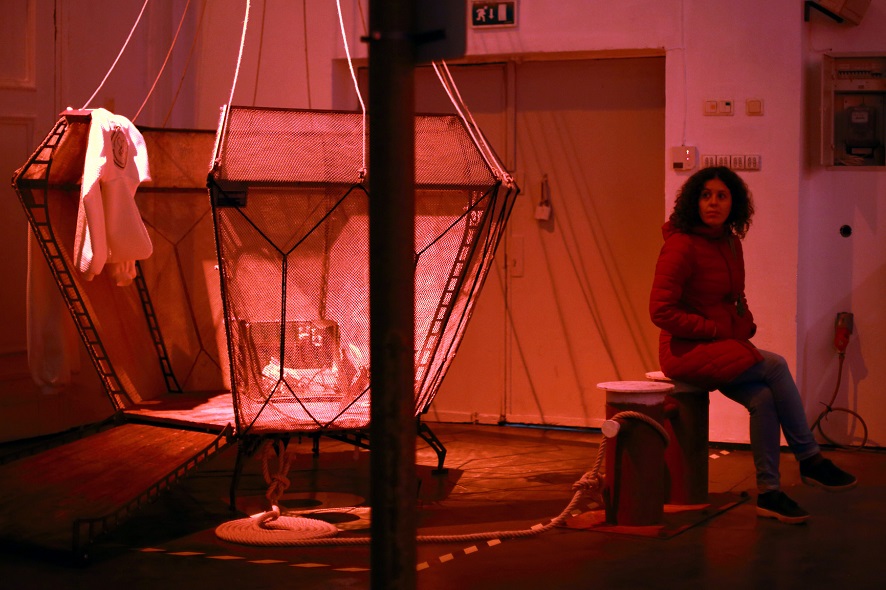The year is 2047. The horrendous impact of the previous decades’ environmental depredations is all too obvious; a catastrophe seems unavoidable. At the harbor of a seaside town, almost out of spite, there emerges a utopian antithesis to this ecological calamity, a society seeking to resuscitate solidarity and sustainable coexistence.
What seems like the plot of a science-fiction novel will be a tangible fact at the Ars Electronica Festival September 7-11, 2017. This year’s FEATURED ARTIST, Linz-based artists’ collective Time’s Up will transform a space in the LENTOS Art Museum into a walk-through situation named Turnton Docklands. Actually, the exhibition is the space itself, which is there to be experienced, touched, examined and worked out.
Time’s Up has been working of experimental situations for over 20 years now. The ensemble describes itself as a laboratory for the composition of experimental situations, or laboratory for the construction of experimental situations. Just as flexible as the name is the group’s makeup. Sometimes five people work on a story, sometimes 15. In any case, whether composition or construction, the worlds into which they regularly convey their audience are most impressive, both in terms of the wealth of details and the intricate narratives they conjure up.
Three members of Time’s Up, Tina Auer, Tim Boykett and Andreas Mayrhofer, gave us insights into their work and revealed something of the fictional world they’re taking us to in September.
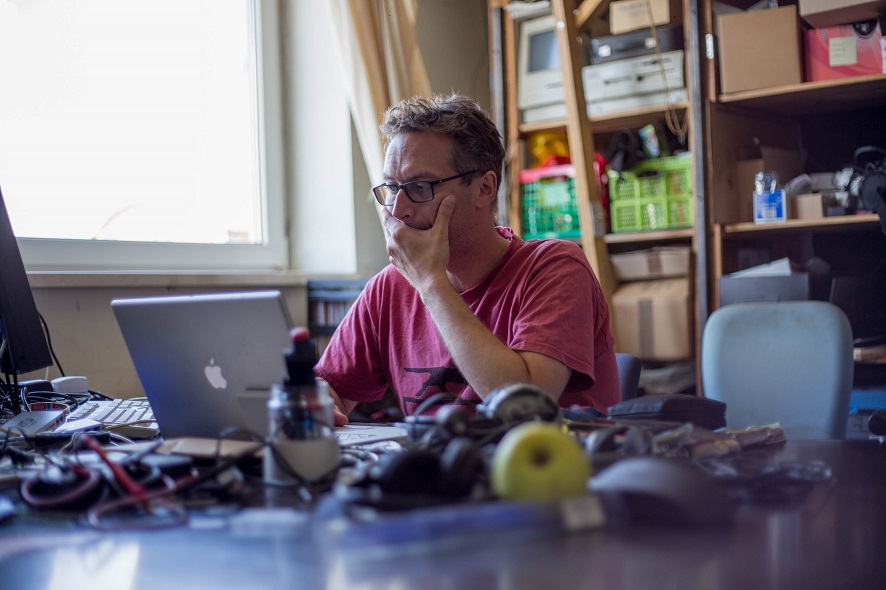
Andreas Mayrhofer at work. Credit: Vanessa Graf
Many of your works are physical narratives. What are they and how did you develop the idea?
Tim Boykett: Physical narratives—the idea is a world, a space you can literally walk into as if people had just exited it. The works leading up to this were also cases of world-building, albeit not yet populated with characters. Over time, we built in people, stories, narratives, and created worlds in which visitors encounter traces of people and their activities. Audience members are prompted to proceed proto-scientifically: What has occurred? Has something bad happened? For example, we staged murders and bank robberies, and, then again, worlds in which everything is suddenly different—like in Turnton Docklands. This is a prognosticated future.
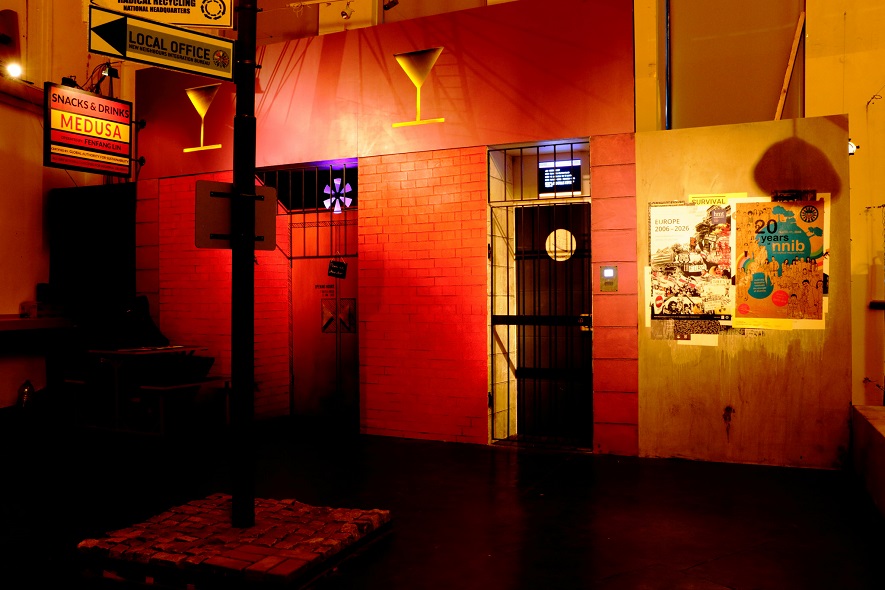
Credit: Time’s Up.
Tina Auer: This is essentially a matter of storytelling. People like to come up with explanations of the world in terms of narratives. It was important to us that we weren’t simply purveying environments somehow for the sake of entertainment. We are definitely not out to explain the whole world, but we’d love to give an account of something. I think that’s how it was at the beginning, this first arrogant endeavor to create a new medium, and that turned into these walk-through narratives.
You have to get away from the idea of getting something served up to you in which you just have to read it or sit back and partake of the entertainment performed in front of you. With our stories, you actually have to work them out. It’s very important for us to involve the audience members to the extent that the more time they spend in the world, the more fascinating it becomes, and the more they investigate, the more details of the narrative they unearth. There always remains an interpretational framework. We’re not quintessential authors; we only provide a few hints, points of departure and significant facts. Then, the individual audience member can take it from there.
Tim Boykett: The essential element is this discussion among the individuals inside the physical narrative—when they start to talk about what they’ve come upon, develop their own hypotheses, and have ideas that go far beyond what we had conceived. Or go off in a totally different direction that makes sense to them personally. We’ve been observing this for 20 years at every installation—the people start to explain what they perceive. It’s a wonderful experience, beholding this diversity.
Tell us about the creative process that goes into producing a physical narrative like this?
Tim Boykett: It differs each time. Maybe the easiest way is to start with a genre like a detective story or a bank heist. In the case of Turnton Docklands, we constructed a world and then sought characters and situations. In other stories, we started with characters and let the story grow out of them.
Andreas Mayrhofer: Some stories are tied to a particular location—for instance, the venue is very small, not even a room you can walk into, just a suitcase.
Tina Auer: So, there’s not just one method or a single structure, a preset checklist that we go down. It’s different every time. And this is also pretty important for us, since we’re rather easily bored. If we had to somehow work our way through an Excel spreadsheet, we would have quit this gig long ago. This way, it’s a new challenge every time, there are continuously new additions to the team, and everybody has novel approaches to how this can work. The result is that it remains somewhat fluid. There’s no hard-and-fast recipe we can simply follow to create physical narratives—sometime this is a good thing but sometimes it’s unfortunate.
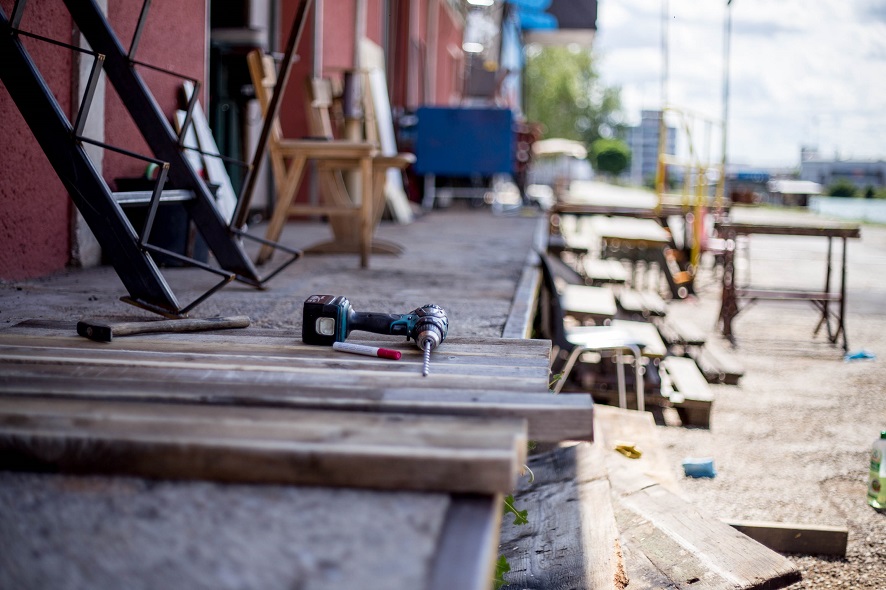
The workshops are located directly in Linz’s harbor. Credit: Vanessa Graf
When do you consider a physical narrative to be complete?
Andreas Mayrhofer: [laughs] Actually, never.
Tina Auer: Occasionally, new content is added, and we insert it in the existing story world. Or there’s a new signal that can be projected or extrapolated into the future. They’re never finished, the story worlds above all, definitely not. Sometimes, in certain situations, with individual physical narratives, you can say: Good, that’s a wrap. But that doesn’t mean you can’t tie something into that element and expand it. You can’t say that this process ever really stops, or that we’re ever totally satisfied.
Tim Boykett: The way the audience interprets what they find and learns more is how it happens with us too. Sometimes, when a piece is finished, we realize that a key idea should actually be totally different than the way we had originally conceived it, and revising it would make it much more significant or expressive. I love when this happens!
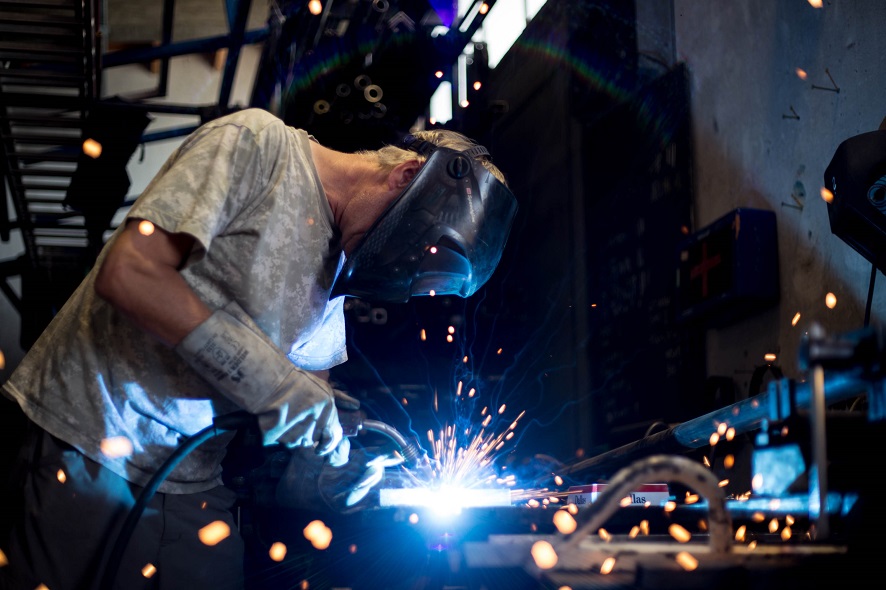
The team’s already working hard on the exhibition. Credit: Vanessa Graf
How long does it take to design a situation?
Andreas Mayrhofer: I’d say between a month and 2½ years.
Tina Auer: Mind the Map took almost three years. We’ve been working on the contents or the basic story world of Turnton Docklands for a year and a half already. Each one’s different.
Andreas Mayrhofer: We’ve gotten rather flexible when it comes to the duration. We used to focus very strongly on the space but now we’ve finally gotten to the point at which even small, self-contained interfaces work in their own right and nevertheless manage to tell a story. So that means that we’ve gotten more mobile.
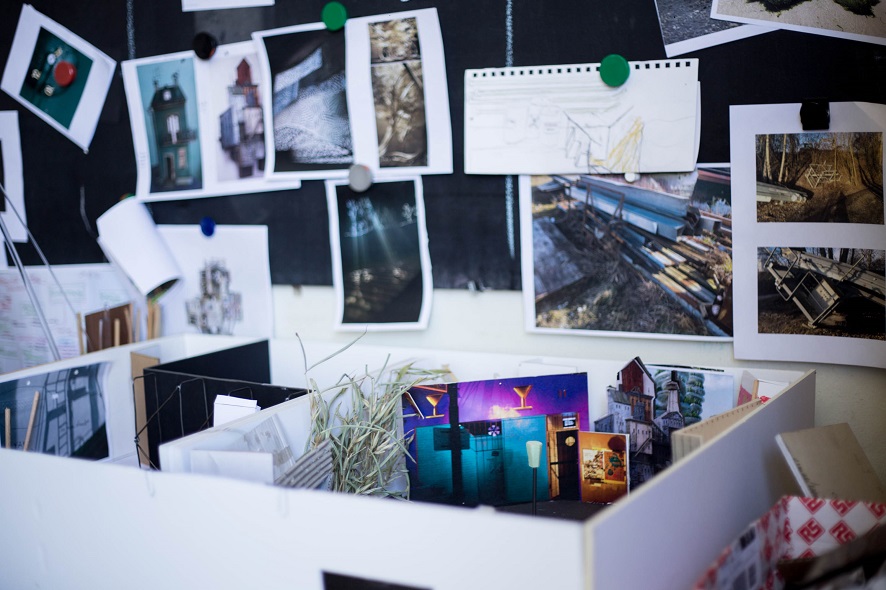
The model for Turnton Docklands. Credit: Vanessa Graf
What can we look forward to at Turnton Docklands in September?
Tina Auer: It’s a possible future; that is, one of the possible futures. We like to formulate the future in plural terms since we proceed under the assumption that there won’t be a single one but rather several of them. In Turnton Docklands, we’re speaking more of the near-term future. It’s set in the year 2047, and our assumption is that the state of the environment will have deteriorated even further. This is extrapolated from the facts & circumstances today, so things will be pretty nasty on the ecological level. But we’re juxtaposing a very positive, almost utopian idea to this with respect to civil society, political life and the economy. By no means do we want to portray only a dystopia, just this apocalyptic state. It’s too boring and just not enough for us. And actually, there are already far too many positive signals and trends that have emerged in recent years. So we’ve extrapolated them too. But keep in mind—we’re not making predictions; these are just suggestions, a best-case outcome showing how the world—or a part of it—could develop.
Andreas Mayrhofer: Well, as far as the environment is concerned, things could be better. We’re proceeding under the assumption of an environmental dystopia, but a mood of optimism prevails socially. What developed out of humankind’s plight was a sort of solidarity, whereby things came to a head and people had to change their ways.
Tina Auer: “Change was our only chance” is one of the various mottos.

Credit: Elisa Unger
Are there already concrete objects that we’ll be encountering in the installation at LENTOS?
Tim Boykett: The newspaper is probably one of the clearest and most telling objects. There’s also the New Neighbors Integration Bureau. The idea behind this is that there are people on the move—former immigrants who are now new neighbors. There are announcements for a festival that’s purportedly being staged right after the installation’s run—also posters for it and discussions about it. This is all part of the confrontation with the matter of how to get along with the new neighbors. This is a core element of the exhibition and of the very concept of Turnton, and this is addressed in various elements throughout the exhibition.
Tina Auer: Another very clear, physical, haptically present object—or actually a backdrop—is the Ocean Recovery Farm. This alludes to the fact that algae can be used very effectively for water treatment purposes, but they’re also a good food supplement. In this connection, we’re getting help and support from a really interesting firm named Ecoduna.
Tim Boykett: You can see this from the examples—we’re taking things that already exist, that are in the process of emerging. Seaweed farming, for example, is something that’s already widespread in Asia and is gaining a foothold in Europe and America. Ecoduna is establishing a presence in Lower Austria. So we’re extrapolating these ideas into the future, technological as well as social ideas.
Andreas Mayrhofer: The complexly interwoven whole pervades various media such as the newspaper I referred to. There’ll also be a bar, a watering hole where locals gather to chat, and, of course, all these future topics are reflected in their conversations, just in passing. Haptically, all the enterprises, initiatives and private spaces are also present in some form or other; they resemble their current counterparts but they’re a bit different simply because they exist at another time.
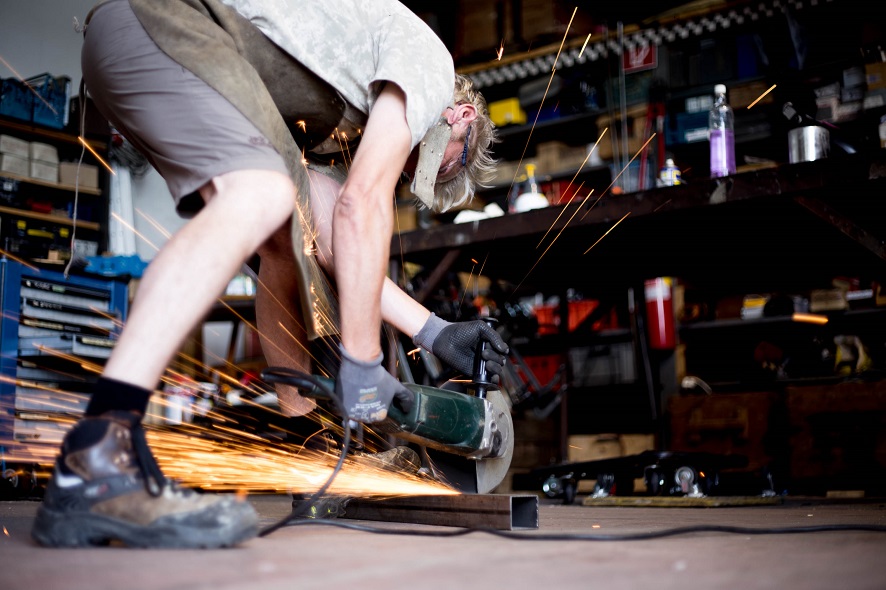
Credit: Vanessa Graf
How are the reactions to the physical narratives? Describe some of the especially memorable ones.
Andreas Mayrhofer: At a murder mystery, for instance, we recorded a few things. That worked really well, because it got things moving in the space. For me personally, it worked so well that, while doing some repair work, I fell for it myself and truly thought there was somebody else there with me.
Tim Boykett: We had another instance where we simulated a storm. People in the space experienced the storm, and when they were ready to exit, they said “O man, I didn’t bring an umbrella with me!” Outside, the sun was shining, and the just totally forgot that it was a normal summer day.
Tina Auer: Basically speaking, the reactions vary greatly, which I find tremendously exciting. After all, everything the audience comes upon is staged. They’re cordially invited to touch it all, browse through it, search about and investigate. Now, there are certain inhibitions people have to overcome because the exhibition is usually set in a very conventional art context in which the house rule is “Don’t Touch the Art!” and not everyone succeeds in crossing the threshold. But the moment they’re past this hurdle, it gets very interesting because there’s often no end to it. We’ve realized that we can’t have anything just laying around just for decorative purposes because literally everything gets scrutinized. This is fascinating, the point at which these people actually immerse themselves and really get into the experience. And some remain for an extremely long time, which we think is great.
Mind The Map, a physical narrative dealing with migration.
One final example—in a narrative about migration, immigration, emigration between Austria and America, I watched an individual who turned out to have had a very similar family history actually break into tears while beholding the work. He said that it was like coming to terms with his own story. So we, in turn, got the story from this person, who was actually there as an audience member. Thus, we told a story and got another one in return, in a wonderful cycle. That’s why I believe that for stories per se, it’s still quite important that they be told.
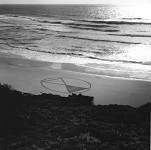
Founded in 1996, Time’s Up has its principal locus at the harbor in Linz, Austria. Its mission is to investigate the ways in which people interact with and explore their physical surroundings as a complete context, discovering, learning and communicating as they do. Their research is based upon constructing interactive situations not unlike the normal physical world, inviting an audience into them and encouraging their playful experience-driven exploration of the space and its behaviors, alone and in groups. In this research process, they use tools from the arts and design, mathematics, science and technology as well as sociology and cultural studies.
The physical narrative entitled “Turnton Docklands” will be presented during the Ars Electronica Festival September 7-11, 2017 at the LENTOS Art Museum, and continue to run there after the festival closes until October 22, 2017.
To find out more about the festival, follow us on Facebook, Twitter, Instagram et al., subscribe to our newsletter, and check out our website at https://ars.electronica.art/ai/en/.
